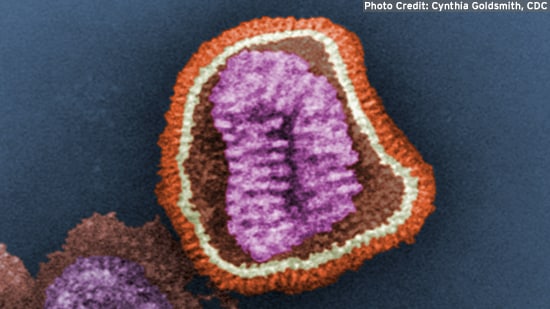
Influenza
WHAT IS INFLUENZA?
Influenza, commonly referred to as “flu” or “seasonal flu,” is a virus that causes a common respiratory infection with fever and often respiratory complications that is easily passed from human to human. Most people have some immunity to the common seasonal influenza and a vaccine is typically available each year. Severe cases occur more frequently in immunocompromised and elderly populations. Approximately 36,000 people die annually in the United States from the seasonal flu.1
Humans can be infected with influenza types A, B, and C viruses. Influenza type A viruses can infect people and other animals including birds, pigs and horses, but wild birds are the natural hosts. They are classified in a variety of subtypes related to the presence of two types of proteins on the surface of the virus particle, the hemagglutinin (H) and the neuraminidase (N) proteins. Influenza B viruses are usually found only in humans. Unlike influenza A viruses, these viruses are not classified according to subtype. Influenza B viruses can cause morbidity and mortality among humans, but in general are associated with less severe epidemics than influenza A viruses. Although influenza type B viruses can cause human epidemics, they have not caused pandemics. Influenza type C viruses cause mild illness in humans and do not cause epidemics or pandemics. These viruses are not classified according to subtype.2
Influenza types A and B viruses are further classified into strains, and new strains emerge annually as the genetics of the strains naturally drift from the previous year’s strains. This means that the annual flu vaccine cocktail is custom-assembled against the likely flu strains, based on the expected drift in the strains.
WHAT ARE THE SYMPTOMS?
Primary symptoms of flu include: fever (usually high), headache, extreme tiredness, dry cough, sore throat, runny or stuffy nose, and muscle aches. Stomach symptoms such as nausea, vomiting and diarrhea can also occur but are more common in children than adults. Complications of flu can include bacterial pneumonia, dehydration, and worsening of chronic medical conditions such as congestive heart failure, asthma or diabetes. Children may get sinus problems and ear infections. The infectious dose is very dependent on the susceptibility of the person infected and the infectivity characteristics of the actual flu virus strain.
HOW IS IT TRANSMITTED?
Transmission can occur one day prior to showing symptoms and up to seven days after symptoms first appear. Patients are most infectious during the first three days of illness. It is transmitted human-to-human via large droplets that are generated by sneezing, coughing or talking, which can be spread over a distance of three to four feet (about 1 meter). It can also be spread by directly touching an infected human, or by touching an object that was contaminated with droplets or touched by an infected human. Airborne transmission can also occur due to the formation of small droplet nuclei over many feet (several meters).
HOW IS IT CONTROLLED?
Vaccination is the primary method to control this disease. This is especially important for those at high risk for severe consequences of influenza. Antiviral drugs may be appropriate for certain individuals based on consultation with their doctor. General preventive techniques that are helpful to prevent spread of influenza include avoiding close contact, staying home when you are sick, covering your mouth and nose with a tissue when coughing or sneezing, washing your hands, and not touching your eyes, nose or mouth. Disinfection of frequently touched surfaces that may be contaminated with viral particles is also an important control measure. These may include door handles, elevator buttons, stair rails, toilet handles, etc.
REFERENCES AND FURTHER INFORMATION
1CDC. Influenza (flu). June 2005.
2CDC. Avian Influenza (Bird flu). November 2005.


